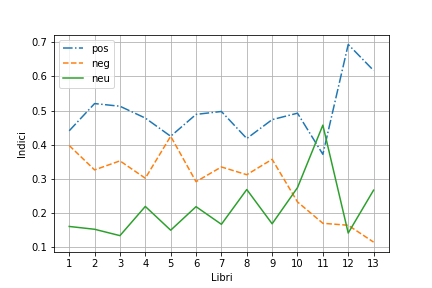Getting Started
In this tutorial, I will show you how to apply sentiment analysis to the text contained into a book through an Unsupervised Learning (UL) technique, based on the AFINN lexicon. This tutorial exploits the afinn Python package, which is available only for English and Danish. If your text is written into a different language, you could translate it before in English and use the afinn package.
This notebook applies sentiment analysis the Saint Augustine Confessions, which can be downloaded from the Gutemberg Project Page. The masterpiece is split in 13 books (or chapters). We have stored each book into a different file, named number.text (e.g. 1.txt and 2.txt). Each line of every file contains just one sentence.
You can download the code from my Github repository: https://github.com/alod83/papers/tree/master/aiucd2021
First of all import the Afinn class from the afinn package.
from afinn import Afinn
Then create a new Afinn object, by specifying the used language.
afinn = Afinn(language=’en’)
Calculate the Sentiment
Use the score give by Afinn to calculate the sentiment
The afinn object contains a method, called score(), which receives a sentence as input and returns a score as output. The score may be either positive, negative or neutral. We calculate the score of a book, simply by summing all the scores of all the sentence of that book. We define three variables> pos, neg and neutral, which store respectively the sum of all the positive, negative and neutral scores of all the sentences of a book.
Firstly, we define three indexes, which will be used after.
pos_index = []
neg_index = []
neutral_index = []
We open the file corresponding to each book through the open() function, we read all the lines through the function file.readlines() and for each line, we calculate the score.
Then, we can define three indexes to calculate the sentiment of a book: the positive sentiment index (pi), the negative sentiment index (ni) and the neutral sentiment index (nui). The pi of a book corresponds to the number of positive sentences in a book divided per the total number of sentences of the book. Similarly, we can calculate the ni and nui of a book.
for book in range(1,14):
file = open('sources/' + str(book) + '.txt')
lines = file.readlines()
pos = 0
neg = 0
neutral = 0
for line in lines:
score = int(afinn.score(line))
if score > 0:
pos += 1
elif score < 0:
neg += 1
else:
neutral += 1
n = len(lines)
pos_index.append(pos / n)
neg_index.append(neg / n)
neutral_index.append(neutral / n)
#unsupervised-learning #sentiment-analysis #book-analysis #text-analysis #data-science
